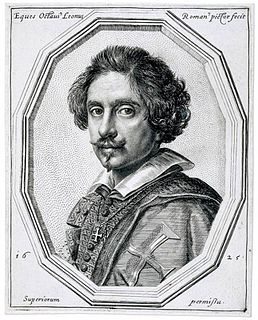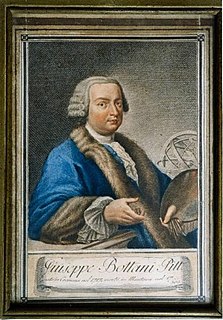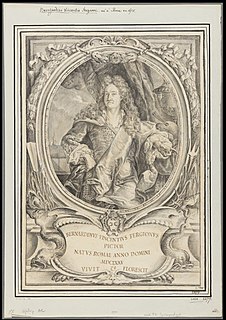Related Research Articles

Guido Reni was an Italian painter of the Baroque period, although his works showed a classical manner, similar to Simon Vouet, Nicolas Poussin, and Philippe de Champaigne. He painted primarily religious works, but also mythological and allegorical subjects. Active in Rome, Naples, and his native Bologna, he became the dominant figure in the Bolognese School that emerged under the influence of the Carracci.

Francesco Albani or Albano was an Italian Baroque painter who was active in Bologna (1591–1600), Rome (1600–1609), Bologna (1609), Viterbo (1609–1610), Bologna (1610), Rome (1610–1617), Bologna (1618–1660), Mantova (1621–1622), Roma (1623–1625) and Florence (1633).

Carlo Cignani was an Italian painter. His innovative style referred to as his 'new manner' introduced a reflective, intimate mood of painting and presaged the later pictures of Guido Reni and Guercino, as well as those of Simone Cantarini. This gentle manner marked a break with the more energetic style of earlier Bolognese classicism of the Bolognese School of painting.

The Albani were an aristocratic Roman family from the 16th to the 19th century. They were of Albanian origin and moved from northern Albania to Italy in the late 15th century. The Albani produced many high ranking figures of the Catholic Church, including Pope Clement XI. Their patrilineal heirs died out in 1852 and their estates were inherited via matrilineal descent by the Chigi, another aristocratic family of central Italy, hence known as the Chigi-Albani.

Andrea Sacchi was an Italian painter of High Baroque Classicism, active in Rome. A generation of artists who shared his style of art include the painters Nicolas Poussin and Giovanni Battista Passeri, the sculptors Alessandro Algardi and François Duquesnoy, and the contemporary biographer Giovanni Bellori.

Giovanni Lanfranco was an Italian painter of the Baroque period.

Ottavio Leoni (1578–1630) was an Italian painter and printmaker of the early-Baroque, active mainly in Rome.

Pier Francesco Mola, called Il Ticinese was an Italian painter of the High Baroque, mainly active around Rome.

The Palazzo Colonna is a palatial block of buildings in central Rome, Italy, at the base of the Quirinal Hill, and adjacent to the church of Santi Apostoli. It is built in part over the ruins of an old Roman serapeum, and it has belonged to the prominent Colonna family for over twenty generations.

Andrea dell'Asta was an Italian painter of the late-baroque period.
Francesco Bassi was an Italian painter active in the early-Baroque period, mainly in his hometown of Cremona, but also in Venice. He was also known as Francesco Maria Bassi the elder.

Giovanni Francesco Cassioni was an Italian engraver in wood. He was born in Bologna, and made a number of portraits of painters for Carlo Cesare Malvasia to use in his Felsina Pittrice in 1678.

Giuseppe Bottani was an Italian painter active in the Baroque period.

Paolo Emilio Besenzi (1608–1656) was an Italian painter, sculptor, and architect of the 17th century, born and active in Reggio Emilia. He lived and worked as a painter, sculptor and architect in Reggio Emilia in the first half of the 17th century. According to Tiraboschi he was sent to France for a short time, at the court of Louis XIII, who would have named him a knight. He trained with Francesco Albani, and was a friend and companion of Lionello Spada. He was buried in the now demolished church of Santa Maria Maddalena, for which he designed the main altar.

Jacopo Zoboli was an Italian painter of the late-Baroque period.
Claudio Francesco Beaumont was an Italian painter, active in a late baroque-style mostly in the Piedmont region.

Benoît Farjat, a French engraver, was born at Lyons in 1646. He was taught the elements of the art by Guillaume Chasteau, whose manner he at first adopted; but he afterwards went to Rome, and acquired a greater command of the graver, and a better style of design, though he is not always correct. He died in Rome in 1724. There are by him some portraits, and various subjects from the Italian masters; the following are the most esteemed:

Bernardino Vincenzo Fergioni (1674–1738) called Sbirretto was an Italian painter of marine views and seaports, stated by Lanzi to have flourished in Rome about the year 1718. Adrien Manglard studied with Fergioni in Rome. Claude Joseph Vernet, too, was welcomed in his atelier sometime after his arrival in Rome in 1732. Among his other pupils were Andrea Locatelli, and Paolo Anesi.

Giacinto Campana was an Italian painter of the Baroque period.

Nicola Vaccaro was an Italian painter, theatre director and opera librettist in Naples. He was known for his religious and allegorical paintings who created easel paintings as frescos. He was a specialist figure painter who regularly collaborated with specialist still life painters on decorative Baroque still lifes and garland paintings. Vaccaro attempted to adapt the stylistic features of 17th-century Neapolitan tradition to the new Classicist and Baroque trends towards increasing Arcadian tendencies. He proposed his own specific form of Academism, aimed at revitalizing the figurative culture in Naples.
References
- Ticozzi, Stefano (1830). Dizionario degli architetti, scultori, pittori, intagliatori in rame ed in pietra, coniatori di medaglie, musaicisti, niellatori, intarsiatori d'ogni etá e d'ogni nazione' (Volume 1). Milan: Gaetano Schiepatti. p. 137.
Attribution:
 This article incorporates text from a publication now in the public domain : Bryan, Michael (1886). "Bellini, Cavaliere Giacinto". In Graves, Robert Edmund (ed.). Bryan's Dictionary of Painters and Engravers (A–K). Vol. I (3rd ed.). London: George Bell & Sons.
This article incorporates text from a publication now in the public domain : Bryan, Michael (1886). "Bellini, Cavaliere Giacinto". In Graves, Robert Edmund (ed.). Bryan's Dictionary of Painters and Engravers (A–K). Vol. I (3rd ed.). London: George Bell & Sons.